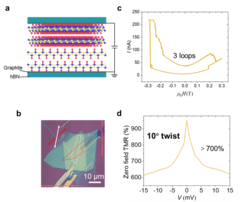Atomically thin all-antiferromagnetic tunnel junction
An international group from the Max Planck Institute of Microstructure Physics, Germany, the University of Nebraska–Lincoln, USA, and the Johannes Kepler University, Austria, reports in Nature an atomically thin all-antiferromagnetic tunnel junction constructed by twisting two bilayers of CrSBr, a two-dimensional (2D) antiferromagnet, which shows a >700% nonvolatile tunneling magnetoresistance at zero field. Their work shows that it is possible to push nonvolatile magnetic information storage to the atomically thin limit.

The discovery of Giant Magnetoresistance (GMR) led to the development of spintronics. In the field of spintronics, the most important structure today is a Magnetic Tunnel Junction (MTJ) that enables, on the one hand, highly sensitive magnetic field sensors that are used to read data in all magnetic disk drives (that store 70% of all digital data today), and, on the other hand, nonvolatile magnetic memories that have features of high performance, reliability and scalability that go beyond today's charge based memories. A classic structure of MTJ comprises a nonmagnetic tunneling barrier sandwiched by two ferromagnetic electrodes. The underlying mechanism is the spin-filter effect for the spin-polarized charge current generated from charges going through the ferromagnetic electrodes. When the magnetizations of the ferromagnetic electrodes are parallel (antiparallel), the magnetoresistance is lower (higher).
However, two critical issues remain in the field of spintronic MTJs for practical applications: relatively slow operational speed and stray field interference due to the intrinsic properties of ferromagnetic materials. Especially, the coupling of long-range stray fields increases with inverse size of the device, which substantially hinders the improvements of device density. Antiferromagnets innately have ultrafast terahertz (THz) spin dynamics owing to the antiferromagnetic exchange coupling that leads to a very low net magnetization and, because of the resulting very low magnetic stray fields, antiferromagnetic spintronic devices can be closely packed. Therefore, it looks like antiferromagnets are the key to solving these critical issues.

Indeed, antiferromagnets, especially a "synthetic antiferromagnetic (SAF)" or an "artificial antiferromagnetic" structure that Stuart Parkin, director of the Max Planck Institute of Microstructure Physics, Germany, invented and patented more than 30 years ago, have been widely used in the ferromagnetic MTJs to effectively eliminate the role of stray fields. However, until 2023, all-antiferromagnetic MTJs without any ferromagnetic components were reported based on non-collinear antiferromagnets, such as Mn3Pt and Mn3Sn. Nevertheless, although such all-antiferromagnetic MTJ further eliminates stray fields, a low stray field still exists because of a small net magnetization in these non-collinear antiferromagnets.
Now, in a paper published in Nature, researchers from an international group have developed a new strategy to fabricate all-antiferromagnetic MTJ even down to the atomic limit, that is, a twisting strategy based on 2D materials, which has been becoming more and more prevalent since twisted graphene bilayer emerged in 2018. By twisting two bilayers of CrSBr, a 2D antiferromagnet, the researchers reported a more than 700% nonvolatile tunneling magnetoresistance ratio at zero field at 2 K. Differing from the conventional MTJs using nonmagnetic MgO as the tunnel barrier, their twisted MTJs adopting the entire twisted 2D magnetic structure acts as the tunnel barrier. By manipulating the magnetic structure, more interestingly, the researchers demonstrated that the performance of the twisted MTJs is tightly dependent on the twisted angle varying from 0° to 90°. Such large twisted-angle-dependence shows great promise in practical applications due to a twist-induced decoupling mechanism at the twisted interface in their 2D all-antiferromagnetic MTJs, which is distinct from the mainstream twist-induced coupling mechanism using strict twist angles in other 2D twisted systems, for example, aforementioned twisted graphene bilayer.
Furthermore, the researchers found that the temperature dependence of magnetoresistance is, surprisingly, much weaker for the twisted as compared with the untwisted junctions, making the twisted junctions even more attractive for pratical applications. The researchers also developed a physical model to calculate tunnel magnetoresistance with arbitrary twist angles, which they believe can be generalized to other twisted systems towards diverse 2D twisted MTJs.
This work was published on August 14, 2024 in Nature, Twist-assisted all-antiferromagnetic tunnel junction in the atomic limit. The researchers at the Max Planck Institute of Microstructure Physics are Yuliang Chen, Haojie Zhang, Chi Fang & Stuart S. P. Parkin, at the University of Nebraska–Lincoln are Kartik Samanta, Naafis A. Shahed & Evgeny Y. Tsymbal, and at the Johannes Kepler University is Arthur Ernst.













